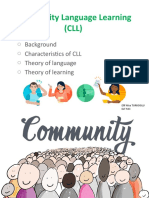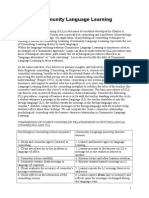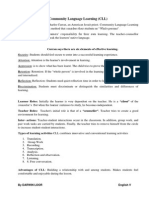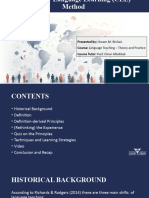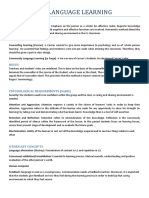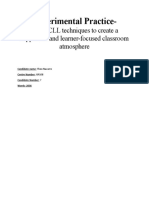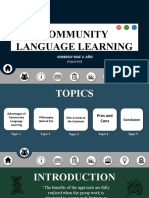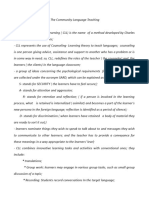0 ratings0% found this document useful (0 votes)
67 views9 pagesCommunity Language Learning + Suggestopedia
community language learning and suggestopedia method
Uploaded by
babeshorty314Copyright
© © All Rights Reserved
We take content rights seriously. If you suspect this is your content, claim it here.
Available Formats
Download as PDF or read online on Scribd
0 ratings0% found this document useful (0 votes)
67 views9 pagesCommunity Language Learning + Suggestopedia
community language learning and suggestopedia method
Uploaded by
babeshorty314Copyright
© © All Rights Reserved
We take content rights seriously. If you suspect this is your content, claim it here.
Available Formats
Download as PDF or read online on Scribd
You are on page 1/ 9
7 Community Language Learning
Background
Community Language Learning (CLL) is the name of + method
developed by Charles A. Curran and his associates. Curran was special-
jst in counseling and a professor of psychology at Loyola University,
Chicago. His application of psychologieal coanseling tecknicues to learn
ing is known as Counseling-Lea-ning. Community Languege Learning
represents the use of Counseling-Learning theory to teach lenguages. As
derives is primary insights, end indeed its orga~
nizing rationale, from Rogerian counseling Rogers 1951). In ‘ay terms,
counseling is one person giving advice, assistance, and support to another
who has 2 problem or is in some way in reed. Cormmanivy Language
Learning draws on the counseling seetaphor t9 redefine the roles of the
teacher (the cornselor) and learners (the clients) in che language class-
room. The basic pracedares of CLL can thus be seen as derivec from the
counslor-lien:rdstonship, Fees
cchniques elso belong to a la:ger set of fortign language tezchin
practices somedmes described humanistic tesbniques (Woskowite
1978). Moskowitz defines humanistic techniques as those that
Dlead what the stadene fees, thinks and knows with what he is learaing in the
target language. Rather than selfleial being the accepratle way of life, sel
{etualization and self-esteem are the ideals the exercises pursue. (The tech-
niques) help buile rapport, cohesiveness, and caring that far transcend what is
sleeady there .. help students ra be themselves, ro accept themselves, and be
proud of themeeives .. help foster a climate of caring and sharing in the for
ign language clas. (Moskowitz 1978: 2)
In sum, hurvanistic techniques exgage the whole person, including the
emotions and feelings (che affective realm) as well as linguistic knowlecge
and behavioral :kil
‘Another language teaching tradition with which Community Lan-
guage Learning is iaked is a se: of practices used in certain kinds of
bilingual edueation programs enc relerred to ky Mackey (1972) a “lan-
{gusge alternation.” Ia language akernatior, 2 message/lesson/classis pre-
sented fist inthe native language and then again in the second languaze.
Students know the meaning and flow of an L2 message from their recall
90
the name indica‘es, CLI
Community Language Learning
of the:parallel meaning and flew of an Ll messege. They begin to holi
tically aiece together a view of the language our o these message sets. In
CLL.a leamer presents a message in L1 to the knower. The message is
translated into L2 by che knower. The learner tken repeats the message in
12, addvessing it to ancther learner with whom Ee or she wishes to
communicate. CLL learners are encouraged t2 attend to tie “overhears”
they experience between other learners ard theie knowers. The result of
the “overhear” is that every member of the grou can urderstand what
any given learner is trying to communicate (La Forge 1983: 45).
Approach: Theory of language and learning
Curran hiinself weote little about his theory cf language. His student La
Forge (1983) has zttempted to be more explicit abovt this dimension of
Commusicy Language Learning theory. La Forge accepts that language
theory must start, though not end, with criteria for sound features, the
sentence, and abstract models oflanguage (La Forge 1983:4). The foreign
language lesrners’ casks are “co apprehend che sound system, assign fan-
damental meanings, and to constrect a basic grammar of she foreign
language.” La Forge goes beyond :his structuralist view of language,
however, and elaborates an alternative theory of language, which is re-
ferrec to as Language as Social Procest:
communication is more than just a message being transmicted from a speaker
toa listener The speaker is atthe same time both subject and object of his,
vn message... communication involves not just the nicirecional transfer
of infermation fo the other, bt the very constzution ofthe speaking subject
in elation tots othe... Communication is an exchenge which
complete without a feedback reaction feom che destinee of che message (La
Forge 1983: 3)
‘This social-process view of language is then elaborated in terms of six
aualises or subprocesses. La Forge also elabccaces 01 the interactional
view of langage underlying Community Languag: Learnig (see Chap-
ter 2): “Language is peop ¢; language is persons in contacy language is
persons in response” (1983: 9). CLL interactions ar2 of ewo distinct and
fundemental kinds: interactions between learners and interactions be-
‘tween learne:s and knowers. Interactions between learners are unpeedict-
able in content but typically azz said to anvolve exchanges of affect.
LLeamer exchanges deepen in intimacy as the class becomes a community
oflearners. The desie t9 be pect of this proving intimacy pushes learners
to keep pace with the learning of the r peers.
Intecaction between learners and knowers is inically dependent. The
learner tells the knower what he or she wishes to say in the target lan-
guage, and the knower tells she learner hew to say ‘t. In later stages,
ct
Alternative approaches and methods
interactions between learner ané knower. are characterized as self
assertive (stage 2), cesentfal and ind:gnant (stage 3), tolzraat (stage 4),
tnd independent (stage 5), These changes of interactive relationship are
paralleled by five stages of language eaming and five stages of affective
conflices (La Forge 1983: 50) :
‘Carran's counseling experience led him toconclude tha: ths techniques
of counseling could te applied to learning in general (this became
Goessting-Leaming) ad fo langugs reicing in parila (Com
smunity Language Learning). The CLL vew of learning isa hols
Tne tere! herman learning i bow cognitive and afectve. This is
termed whole-person learning. Sach learning takes place in 2 com-
SSunteaeve svetion where teachers and learners ar invlved in “an
interaction... .;n which both experiexce a sensc°of their cwn wholeness”
‘Curran 1972: 90). Within his, che development of the learner's elation
Ship wth the teacher is central. The p:ocess's divided into five stages and
compared to the ontogenetic develorment of the child.
Ta the firs, “birth” sage, feelings of security and belonging ere esteb-
ished. In the second, 28 the learner's abilities improve, the learner, as
child, begins to achieve 2 measure of independence from: the parent. By
the thicd, the learner “speaks independently” ard may need to assert his
br her own identity, often rejecting unasted-for advice. The fourth stage
sees the learner as secure enough £9 take ertcism, and by the last stage,
+he leacner merely works on improving style and knowledge of linguistic
appropriateness. By the end of the process, the child hai become adult.
‘The learner knows everything the teacher does and can become kaower
for a new learnet. The process of learning 4 new language, then, is like
being reborn and developing a new persona, with all the trials and chal-
lenges that are associated with birth and maturation. .
‘Curran in mary places discusses what he cal's “consensual validation,
or *convalidation,” in which mucual watmta, understancing, and a pos
sive evaluation of the other person's worth develop betwee. the teacher
anc the leares. A relationship characterized by convaiidation is con-
siderec essential to the learning process and is a key element of CLL
classroom procedures. A. group ef ideas concerning the psychological
requirements fo: successful learning are collected under the acronym
SARD (Curran 1976: 6), which can >¢ explained as follows:
S stands for security. Unless learners feel secure, they will find ic eiffcul to
enter into a successful eacning experience.
A siancs for attention and aggression. CLL recognizes that a loss of attention
should be taken as an indieation of ch learner's lck of involvement in
earning, the implication being that variery in the choice of earner tasks will
increase atention and therefore promote earning, Aggression applies to the
‘way in which a child, having learned something, seees 2a oppoctunity to
2
Cormmunity Language Learning
‘now his or her strength by taking over and cemonstrating what has been
learned, using the new knowledge 2s rool fer selassertion,
R stands for retention and reflection, Ifthe whale pecson is involved in the
learning process, what is retained 's internalized end beceraes« part cf the
learner's sew persora in the fozeign angusge. Reflection is a consciously
identified peciod of silence within the framewatk ofthe lesson for the s8-
dent “to focus on she learning ‘orces of the lait haus, 0 assess his present
stage of cevelopment, aad to reevaluste furure goals” (La Ferge 1983: 68).
D denotes discrimination. When learners “have cetsined a body ef mate‘
they are ready to sort it out and sez how one thing relates to another” (La
Forge 1983: 69). This discrimination process becomes mors refined and ul-
‘imately *enables the students to use the language for pusposss of com-
‘munication cutside the elassrocm” (L: Forge 1983: 69).
These central aspects of Carran’s leening ahiosophy address not the
psycholinguistic and cognitive processes invalved in second language 2c-
‘quisition, bur rather the personal commitmenss that learners need to
make tefore language acquisition processes can operate.
Design: Objectives, syllabus, learning activities, roles of
learners, teachers, and materials
linguistic or commiinicative competsnce is specified ouly in social
«rs, explicit linguistic or communicative objectives are cot defined in
CLL. Mostof what has been writtea aboutit describes its use in introduc-
tory conversation courses in a foreign language. CLL does not use @
conyentional language syllabus, which sets out ia advance the g-ammar,
vocabulary, and other language ‘terss to be taught and the order in which
they will becovered. The progression is topic-bazed, with leamers nomi
rating things they wish ro talk about and messages they wish to com
raunicate tc other learners. The teacher's responsibilty is to provide a
conveyance for these meanings in a way approprate to the learners’
proficiency lev. Zn this sense, then, 1 CLL syllabus emerges from the
interaction between the leamer’s expressed commuicative intentions
and the teacher's reformulations of these into suitable target-language
uwxerances, Specific grammatical points, lexical pattercs, and genercliza-
tions will scmetimes be isolated by the tezchee for mot detailed study
and analysis, and subsequent specification of these as a reospective
account of whet che course covsred could be a way of ceciving a CLL
language syllabus.
‘As with mos: methods, CLL Combines ianovative learning tasks and
ities with conventional ones. They include:
1. Translation. Learners form a small circle. A learner whispers a mes-
ssage or meaning he or she wants to express, the ceacher translates it
93
thods
Alternctive approaches and:
into (and may interprer it in) the target language, and the learner
repeats the teacher's translation.
2. Group werk. Leamers may engage it. various group tasks, such a8
small-group discussion of 2 op, preparing 2 conversation, preparing
2 summary of a topic for presentaticn tc another group, preparing
story that will be presented to che teacher and the rest of the class.
3. Recording. Stadents record conversations in the target language.
4. Transcription, Seadenis trarseribe urterances ard conversations they
have recorded for practice and analysis of linguistic forms.
5. Analysis. Stadeats analyze and study :ranscripricns of carget-language
Sentences in order to focus on particular lexical usage or en the appl-
‘ation of particular grammar rules
6 Reflecon and observetion Lemners reflect and rerorton their expe-
wanes ofthe cast as clas tis groups, This usually consis cf
expressions of feelings ~ sense of one another, rezctions to silence,
concern for something oss and soon.
2, Listening. Students listen tc a monclegue by the teacher involving
glements they might have elicited or overheard in class interactions.
8. Free conversation. Students ergage in fee conversation with the
teacher 2¢ with other learners. This might include discussion of what
they learned as well as feelings they kad zbovt how they learned,
Learner roles in CLL are well defined, Lea-ners become members of a
community ~ their fellow learners and tne teacher ~ and learn through
interacting with the community, Learning isnot viewed as an individual
accomplishment out as something thet is achieved collaboratively.
Learners are expected to listen anentively tc the kaower, to freely provide
_meanings they wish to express, co repeat target urterznces without hesita-
tion, to support fellow members of the community, ro report deep inner
feelings and frust:etioas as wel as joy and pleasure, ard to become
counselors of o:he: learners. CLL learners are ypically grouped in circle
of six to twelve learners, with the number of knowers varying from one
er BrOUp to one per student.
Paaener oes ce keyed rth ve stages of language earning otlined
catles. The view of the learner is an organic one, with each new role
growing developmentally out of the one preceding. These role charges
are not easiy or automatically ach eved. They are in fact seen as oUt-
comes of afletive crises
‘When faced with a new cognitive task che leerrer must solve an affective r-
sis With the olion ofthe fe affective ee, ove foreach CLL age te
studen: progresses from a lower to s higher stage af development. (La Forge
1933.44)
94
Coneninity Language Learning
The teacher's role derives frcm the functions of the counselor in
Rogerian psychological counseling. The counselor's role is to respond
calmly and nonjudgmental, in a supportive manner, and help the client
try to understand his or her problems beter by epplying order and analy.
sis to them. “One of the functions of the counseling response isto relate
affect... to cognition. Underscanding the language 0 ‘feeling’ the coun
sclor replies in the language of cognition” (Curran 7976: 26) Ie was the
model cf teacher as counseler that Curran ateemoted to ring to language
fearing.
There is alto room for actual counseling in Community Language
Learning: “Pezsonal learning conflets... .anger, anxiety and similar poy.
chological disturbance — understoad and responded to by the teacher's
counseling sensitivity ~ are indicacors of deep pesscnal investment”.
Rardin, in Curran 1976: 103).
More specific teacher roles are, like thote of the students, keyed to the
five developmental stages. In the early stages of learning, the teacher
operates in a supportive role, providing target-lenguage translations and
4 mode! for imitation on cequest ofthe clients, Later, interaction may be
initiated by the students, and the teacier monitors learner utterances,
providing assistance when requested. As learning progresses, students
become increasingly capable of accepting criticism, and the teacher may
intervene directly to correct deviantutcerances, supply idioms, and advise
‘on usageand fine poin's of grammar. The teacher’ role isinitelly likened
to that of a nurturing parent. The student gredually “grows” in ability,
acd the nature of the selationship changes so that the teacher's position
becomes somewhat dependent on the learner. The kroner derives a sense
of selfwortk through requests for tae knower's assistance.
Since a CLL course evolves out ofthe interactions ofthe community, a
textbook is not considered a necescary componeat. A tex:book would
impose @ particular body of language content or the learners, thereby
impecing their growth and inceracton. Mater als may be developed by
the teacher as the course develops, although these gererally consist of
lirde more than summaries on the blackooard or ovedhead projector of
some of the linguistic features of conversations generated by students.
Conversations may also be transcribed and distributed for seady and
analysis, and learners may work in groups co produce thsi: own mate=
rlals, such as scripts for dialogues and minideamas.
Procedure
Because each Community Language Learning course is in a sease a
‘unique experience, description of eypical CLL p-oceduces in a class
95
Alternative approaches and methods
is probleme, Stevi (1980; dings berween Slaten
ised directly on-the model proposed by Curran} and personal
oo are on guch av tow acused by ferent advects of
CLL (eg, La Forge 1983). The following description attempts to capture
some typical activites in CLL dlaises
Generally, the observer will see a circle of learners all facing one an-
other The learners are linked in some way to knowers or a sicgle knower
as teacher The first class (2nd subsequent classes) may begin with a
period of silence, in which learners try to determine whatis supposed to
fappen in theiclonguage class. In later clases, learners may si in silence
while they decide what co talk zbout (La Forge 1983: 72]. The observer
may note that the awkwardness of silence becomes sufficiently agorizing
for someone 10 volunteer to break the silence. The knower may use the
volunteered comment as a way of :
concaets or asa stimulus for language i
felt about the perioe of silence. The knower may encourage learners t0
add:ess question to one another or to the kaower These may be ques-
tions on any subject a learner is curious eacugh to inquire about. The
questions and answers may be tap-recorded for later use, asa seminder
and review of topics discussed and language wed.
“The teacher migh: chen form the class into ‘acing ‘ines for 3-minuse
pair conversations, Thess are seen as equivalent to the brief wrestling
sessions by which judo students p-actice. Following this the class might
be re-formed inta small groups in which asiagletop.c, chosen by the class
or the group, is discassed, The summary of the group discussion may be
presented to another geoup, who in turn try to repeat or paraphrase the
* summary back to th: origina! group.
In an intermediate or advanced class, a teacher may encourage groups
1 prepare a paper drama for preseatation to the res: of the class. paper
drama group preparts a story that is told oF shown to the counsslor. The
counselor provides or corrects argetlarguage staterrents and suggests
impzovements to the story sequerce. Students are then given materials
‘vith which they prepare large picture cards to accompany their story.
‘After practicing the story dialogue and prepa-ing the acccmpanying pic-
tures, each group presents its papar drama to che rest of the class. The
students accompany theis story with music, puppets, and drums as well
2s with their pictures (La Forge 1983: 81-82).
Finally, the teacher asks learners to reflect on the language class, as &
class or in groups. Reflection provides.the basis for discussion of con-
teacis (written or oral contracts that learners end teachers have agceed
pon and that spzcify what they agree to accomplish within the couse),
personal interaction, feelings toward the knower and learner, and che
sense of progress and frustration.
perio.
56
Conumunity Language Learning
Dicer Stbinig (in Stevick 1980: 185-186) presents a protoc
what fiw cays CLL clan cove, which scuaed ese
4. Informal greetings and self-intcoduccions were made.
2. The teachee made a statement of the goas and guidelines for the
3. Aconversaticn ia the foreign language took place.
2.4 cicle was formed 50 that everyone hac vial contact with etch
y a
2)- One student initiated conversation with ano-her student by givin
4 message in the L1 (English). chat
4) The instructor, standing behind che srudect, whispeced a close
equivalent of the message in tke L2 (German).
4) Thesnudene then repeated the L2 sressege to its addressee and into
» he etserocer as wel.
¢) Each student had a chance to compose and record a few mesiages.
The tape recorder was rewound and replayed at interval,
Each student repeated the meaningin Engiish of what heot she had
said in the L2 and helped tc refresh the memory of others.
4, Students then pasticipated in a reflection pesiod, in which ehey were
ike to express cheir feelings abowr the prevousexpeience with otal
5. From the materials jast recorded the insructo: chose sentences to
write on the blackbosrd chat highlighted elements cf grammar, spell
ing, anc peculiarities of capitalization in the L2.
6. Students were encouraged t0 ask questions abcut any of the items
above
7, Students were encouraged to copy sentences fiom the board with
notes on meaning and usege. Ths becsme thc “textbook” for kame
saad
Conclusion
Community Language Learning places unusual demands on langua;
teachers, They mist be highly proficient and sense to tusce mt both
Li and 12. They must be familiar with and sympathetic to the role of
counselors in psyckological counseling, They must resistthe presaute “to
teach” ir the tedtional senses, The tescher mast also be selatively non
directiveand must be prepared to accep: and even encourage he “adoles-
You might also like
- The TESOL Encyclopedia of English Language Teaching - 2018 - Ali - Community Language LearningNo ratings yetThe TESOL Encyclopedia of English Language Teaching - 2018 - Ali - Community Language Learning5 pages
- Community Language Learning 20230823 232037 0000No ratings yetCommunity Language Learning 20230823 232037 000026 pages
- Community Language Learning: September 2014No ratings yetCommunity Language Learning: September 201417 pages
- Extract of Community Language Learning StudentsNo ratings yetExtract of Community Language Learning Students2 pages
- Ommunity Language Learning: by Charles A. CurranNo ratings yetOmmunity Language Learning: by Charles A. Curran16 pages
- Cambridge Delta Experimental Practice - UNo ratings yetCambridge Delta Experimental Practice - U17 pages
- Community Language Learning (CLL) Is The Name of A Method DevelopedNo ratings yetCommunity Language Learning (CLL) Is The Name of A Method Developed2 pages
- Lesson 8 Modern Language Teaching Methodlogies 1No ratings yetLesson 8 Modern Language Teaching Methodlogies 14 pages
- Community Language Learning Suggestopedia Whole LanguageNo ratings yetCommunity Language Learning Suggestopedia Whole Language25 pages
- Breaking Barriers - Community Language Learning For Teenage Elementary StudentsNo ratings yetBreaking Barriers - Community Language Learning For Teenage Elementary Students5 pages
